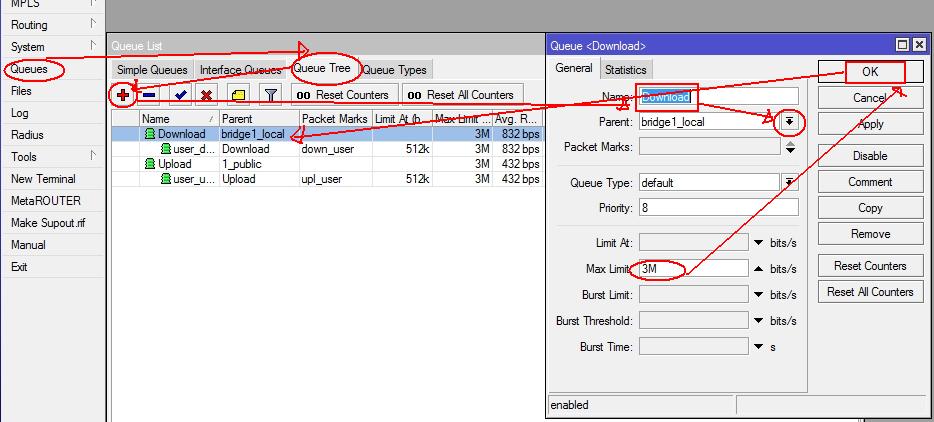Limit Bandwidth Mikrotik Dengan Queue Tree
Belajar Mikrotik Dasar Firewall Mikrotik
Explanation Queue Tree & PCQ in Mikrotik

Setting and management in Mikrotik Bandwidth cannot be separated from the Queue feature. There are two types of the queue which can be used in Mikrotik, namely Well, this time we will discuss the Company Queue Tree & PCQ (Per Connection Queue) as well as application in the Mikrotik. 4. Used to recognize the current direction and is used because it can Manage bandwidth in a fair, equitable and massive. PCQ on Mikrotik used in conjunction with Queue, either Simple Queue, and Queue Tree. To make it easier to understand the concept of Well, to make a configuration like this, I have to make one rule 10 rule parent and child Queue Queue for each client. For current conditions are only 10 PC it’s ok, do not matter. But imagine if his existing PC 100? 200? What if I manage is a WiFi Hotspot network with clients who ga course his number? What yes I have to make hundreds rule for each client? Tired dongg. Therefore, I can use this feature to perform management PCQ massively bandwidth to all clients on a large scale. By using this PCQ, although not necessarily the number of clients and very much, we just need to make one or two configurations Queue. Combining Simple Queue and Queue Tree. For an explanation of Simple Queue I’ve discussed here:How to Limit (Limit) Bandwidth Mikrotik with Simple Queue
Queue Tree serves to implement more complex functions in a bandwidth limit on the proxy where the use of packet marks its functions better . Used to limit one direction only connection either download or upload. Queue Tree In general, this does not look different from Simple Queue.Some Differences Simple Queue and Queue Tree:
1. Simple Queue
2. Queue Tree
Explanation of some arguments in Queue Tree:
Parent: useful for determining whether the queue who has served as a child queueGlobal in : Representing all input interfaces in general. The point here interface that receives input data/traffic before filtering such as traffic uploadGlobal-out : Representing all output interfaces in general. The point here interface to output data/traffic filtered as traffic downloadGlobal-total : Representing all input and output interfaces simultaneously, in other words, represents the union of the global and global-in-out. Packet Mark: Used to mark the package that has been marked in / IP firewall mangle.Priority (1 s / d 8): Used to prioritize child queue of another child. Priority does not work on the parent queue. Child Queue that has priority one (1) will reach the limit-at first than on the child queue priority (2).Queue Type: Used to select the type of queue that can be made to a special queue typesPCQ, please refer to the following analogy: I have 10 PC which I will share a maximum bandwidth of 1 Mb and a minimum bandwidth of 256 kb each PC. If only one of my PC is online then he will be able to BW max 1 Mb, but if there are two PC online BW divided by 2, and so on up to 10 with the distribution of bandwidth evenly.PCQ Classifier function classifies the direction of the connection, for example, if the classifier used is src-address on the Local interface, then the flow will be pcq upload connections. So also with dst-address will be pcq download.Layer7 features and packet marking uses mangle to mark files that are normally downloaded and then limited download bandwidth using Queue Tree + PCQ. So that each client will get a limited download connection and unlimited browsing.
Gallery Limit Bandwidth Mikrotik Dengan Queue Tree
 Videos Matching Full Bandwidth Management Parent Queue Tree
Videos Matching Full Bandwidth Management Parent Queue Tree
Konfigurasi Manajemen Bandwidth Simple Queue Pada Router
 Videos Matching Full Bandwidth Management Parent Queue Tree
Videos Matching Full Bandwidth Management Parent Queue Tree
Analysis Of Effectiveness Of Using Simple Queue With Per
Konfigurasi Manajemen Bandwidth Simple Queue Pada Router
How To Give Icmp High Priority In Mikrotik Router
 Manajemen Bandwidth Dengan Queue Tree Pada Mikrotik
Manajemen Bandwidth Dengan Queue Tree Pada Mikrotik
Paper Title Use Style Paper Title

 Full Bandwidth Management Parent Queue Tree
Full Bandwidth Management Parent Queue Tree
 Wilem Kogoya Cara Membatasi Bandwidth Mikrotik
Wilem Kogoya Cara Membatasi Bandwidth Mikrotik
 Netflix Youtube Traffic Shaping With A Mikrotik Router
Netflix Youtube Traffic Shaping With A Mikrotik Router
 Name Wifidownload Parent W I F I Packet Mark Paket Download
Name Wifidownload Parent W I F I Packet Mark Paket Download
 Cara Limit Bandwidth Di Mikrotik Dengan Simple Queue
Cara Limit Bandwidth Di Mikrotik Dengan Simple Queue
 Mikrotik Configuration For Transparent Web Proxy Pdf
Mikrotik Configuration For Transparent Web Proxy Pdf
 The Problem With Queue Size Engineer Life
The Problem With Queue Size Engineer Life
 Mikrotik Qos Syed Jahanzaib Personal Blog To Share Knowledge
Mikrotik Qos Syed Jahanzaib Personal Blog To Share Knowledge
Mikrotik Id Simple Queue Vs Queue Tree
 Amazon Simple Queue Service Aws Documentation Prevent A
Amazon Simple Queue Service Aws Documentation Prevent A
 Cara Limit Bandwidth Menggunakan Simple Queue Mikrotik Ayo
Cara Limit Bandwidth Menggunakan Simple Queue Mikrotik Ayo
 Rb951ui 2nd Mikrotik Rb951ui 2nd Hap Indoor Wireless Router
Rb951ui 2nd Mikrotik Rb951ui 2nd Hap Indoor Wireless Router
 Tutorial Mikrotik Pembagian Bandwidth Dengan Queue Tree
Tutorial Mikrotik Pembagian Bandwidth Dengan Queue Tree
 Full Bandwidth Management Parent Queue Tree Mikrotik Youtube
Full Bandwidth Management Parent Queue Tree Mikrotik Youtube
 The Problem With Queue Size Engineer Life
The Problem With Queue Size Engineer Life
 Videos Matching Full Bandwidth Management Parent Queue Tree
Videos Matching Full Bandwidth Management Parent Queue Tree
 Cara Limit Bandwidth Menggunakan Simple Queue Mikrotik Ayo
Cara Limit Bandwidth Menggunakan Simple Queue Mikrotik Ayo

0 Response to "Limit Bandwidth Mikrotik Dengan Queue Tree"
Post a Comment